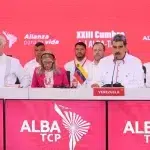
The moment when Venezuelan then-Minister for Communication and Information Ernesto Villegas addressed the crowd mourning Commander Hugo Chávez, asking for calm before the funeral chapel was opened to let millions of Venezuelans say a final goodbye at the Military Academy in Caracas. March 6, 2013. Photo: Instagram/@ernestovillegaspoljak.





